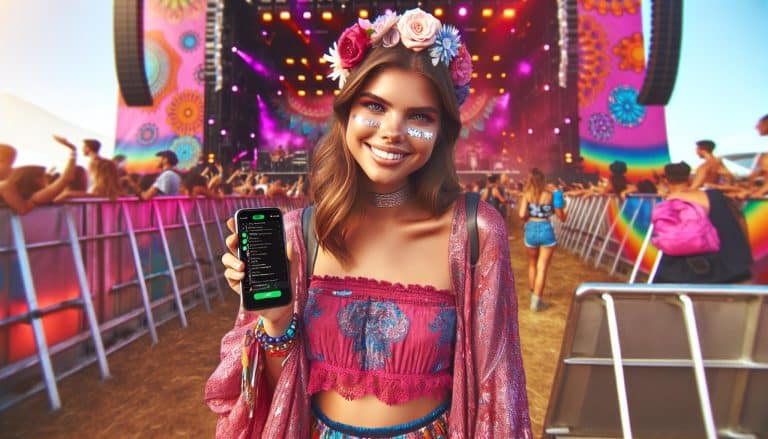Are you struggling to reach the right audience for your upcoming festival? Custom audiences might be the game-changer you’re looking for. By leveraging data from your existing customer base, you can create highly targeted marketing campaigns that resonate with potential attendees.
Custom audiences allow you to tailor your message to specific groups based on their interests, behaviors, and demographics. This precision targeting not only improves your marketing efficiency but also increases ticket sales and overall event success. In an increasingly competitive festival landscape, mastering custom audience strategies can give you a significant edge over your rivals.
Key Takeaways
- Custom audiences enable targeted festival marketing by leveraging data from existing customer interactions and website visits.
- Segment custom audiences based on specific criteria like genre preferences, location, and engagement level for more personalized campaigns.
- Utilize retargeting strategies to re-engage interested users who haven’t yet purchased tickets, increasing conversion rates.
- Implement lookalike audiences to expand reach while maintaining targeting relevance, finding new potential attendees similar to existing fans.
- Regularly update and refine custom audiences, testing different ad creatives and messaging to maximize performance and drive ticket sales.
Understanding Custom Audiences for Festival Marketing
What Are Custom Audiences?
Custom audiences are groups of people who have interacted with your festival brand in specific ways. These interactions include:
- Visiting your website
- Using your mobile app
- Subscribing to your email list
- Purchasing tickets to past events
- Following your social media accounts
Custom audiences allow you to target your marketing efforts to individuals who have already shown interest in your festival, increasing the likelihood of engagement and ticket sales.
Benefits of Custom Audiences for Festival Marketing
- Improved Ad Efficiency: Custom audiences enable you to focus your advertising budget on people who are more likely to attend your festival, reducing wasted ad spend.
- Higher Conversion Rates: By targeting individuals who are familiar with your brand, you increase the chances of converting ad views into ticket sales.
- Enhanced Audience Insights: Custom audiences provide valuable data about your most engaged followers, helping you refine your marketing strategies over time.
- Lookalike Audience Creation: Use your custom audiences to find new potential attendees with similar characteristics to your existing fans.
Creating Custom Audiences for Festival Marketing
- Website Visitors: Use pixel tracking to create audiences based on specific pages visited or actions taken on your festival website.
- Email Subscribers: Upload your email list to create a custom audience of subscribers who have opted into your communications.
- Past Attendees: Create a custom audience of previous ticket buyers to promote upcoming events or early bird specials.
- Social Media Engagement: Build audiences based on users who have interacted with your festival’s social media content.
- App Users: If your festival has a mobile app, create audiences of users who have downloaded or engaged with the app.
Also Read: Boost Event Sales: Master Pixel Tracking for Ticket Conversions
Segmenting Custom Audiences for Targeted Campaigns
Divide your custom audiences into smaller segments based on specific criteria:
- Genre Preferences: Target fans of specific music genres or festival activities
- Geographic Location: Create location-based audiences for targeted promotions
- Purchase History: Segment based on ticket types or add-ons previously bought
- Engagement Level: Separate highly engaged fans from occasional attendees
- Regular Updates: Refresh your custom audiences frequently to ensure accuracy and relevance.
- Exclusion Lists: Create exclusion lists to avoid showing ads to people who have already purchased tickets.
- Cross-Platform Targeting: Use custom audiences across multiple advertising platforms for a cohesive marketing strategy.
- A/B Testing: Experiment with different ad creatives and messaging for each custom audience segment to maximize performance.
- Retargeting Campaigns: Use custom audiences to retarget users who have shown interest but haven’t yet purchased tickets.
By leveraging custom audiences in your festival marketing campaigns, you can create more personalized and effective promotions that resonate with your target attendees. This targeted approach leads to improved ad performance, higher conversion rates, and ultimately, increased ticket sales for your festival.
Types of Custom Audiences for Festivals
Custom audiences are powerful tools for targeting specific groups of people based on their interactions with your festival or related activities. Here are the main types of custom audiences you can use for festival marketing campaigns:
Customer List Audiences
Customer list audiences are created by uploading existing customer data to match with active users on advertising platforms. These audiences include:
- Email subscribers
- Past ticket buyers
- VIP attendees
- Contest participants
Benefits:
- Target known festival supporters
- Personalize messaging based on purchase history
- Increase loyalty and repeat attendance
To create customer list audiences:
- Export data from your CRM or ticketing system
- Clean and format the list according to platform requirements
- Upload the list to your chosen advertising platform
- Allow time for matching and audience creation
Website Visitor Audiences
Website visitor audiences are generated based on people who have visited your festival website or taken specific actions. These audiences include:
- All site visitors
- Ticket page viewers
- Lineup browsers
- FAQ readers
Benefits:
- Retarget interested prospects
- Deliver tailored ads based on specific page views
- Capture potential attendees who didn’t complete purchases
To create website visitor audiences:
- Install tracking pixels on your festival website
- Set up event tracking for key actions (e.g., ticket page views)
- Create audience segments based on specific behaviors
- Implement retargeting campaigns to re-engage visitors
Engagement-Based Audiences
Engagement-based audiences are created from people who have interacted with your festival’s content or ads across various platforms. These audiences include:
- Social media engagers (likes, comments, shares)
- Video viewers
- Ad clickers
- App users
Benefits:
- Target highly interested individuals
- Leverage warm leads for conversions
- Increase ad relevance and performance
To create engagement-based audiences:
- Set up tracking for social media interactions
- Create custom audiences based on video view duration
- Segment ad engagers by campaign or ad set
- Use app activity data to target active users
Lookalike Audiences
Lookalike audiences are created by finding users who share similar characteristics with your existing custom audiences. These audiences include:
- Lookalikes of past ticket buyers
- Lookalikes of high-value customers
- Lookalikes of engaged social media followers
- Lookalikes of app users
- Expand reach to new potential attendees
- Maintain targeting relevance while scaling campaigns
- Improve ad performance with pre-qualified prospects
To create lookalike audiences:
- Select a high-performing custom audience as a source
- Choose the desired audience size and location
- Allow the platform’s algorithm to find similar users
- Test different lookalike percentages for optimal results
By utilizing these types of custom audiences, you can create highly targeted marketing campaigns that resonate with potential festival attendees, ultimately driving ticket sales and enhancing overall event success.
Creating Custom Audiences for Your Festival

Custom audiences enable targeted marketing for your festival, increasing ticket sales and engagement. Follow these steps to create effective custom audiences for your campaign.
Setting Up Your Meta Ads Account
Create a Meta Ads Manager account and link it to your festival’s Meta page to access the Audiences feature. Navigate to the Ads Manager dashboard and select “Audiences” from the menu. Click “Create Audience” and choose “Custom Audience” to begin the process.
Importing Customer Data
Upload customer data to create custom audiences in your Meta Ads account:
- Customer Lists: Import email lists of past attendees or newsletter subscribers.
- App Activity: Use data from your festival app to target engaged users.
- Website Activity: Leverage visitor data from your festival website.
- Offline Activity: Include data from in-person ticket sales or event check-ins.
Ensure your data complies with privacy regulations and Meta’s policies before uploading.
Installing and Using Meta Pixel
Meta Pixel is a code snippet that tracks website visitor activity:
- Generate your Meta Pixel code in Ads Manager.
- Install the code on your festival website.
- Set up event tracking for specific actions like ticket purchases or page views.
- Create custom audiences based on website interactions.
Use Meta Pixel to retarget website visitors and create lookalike audiences for expanded reach.
Leveraging Event Engagement Data
Utilize data from past festival engagement to create targeted audiences:
- Social Media Interactions: Target users who engaged with your festival’s posts or ads.
- Video Views: Create audiences of users who watched your festival promotional videos.
- Event Responses: Include users who showed interest in your Facebook events.
Segment these audiences based on engagement levels to tailor your marketing messages. For example, create separate audiences for users who watched 25%, 50%, or 75% of your video content.
Strategies for Using Custom Audiences in Festival Marketing
Custom audiences provide powerful targeting options for festival marketers. Implement these strategies to maximize the impact of your marketing campaigns and drive ticket sales.
Retargeting Past Attendees
Create a custom audience of past attendees using data from previous events. This audience is likely to be interested in your festival and can be targeted with personalized ads to encourage repeat attendance. To effectively retarget past attendees:
- Segment by attendance history: Divide your audience based on the number of times they’ve attended your festival.
- Tailor messaging: Craft ads that highlight new features or artists for returning attendees.
- Offer early bird discounts: Provide exclusive pre-sale access or discounts to past attendees.
- Use dynamic content: Personalize ads with images or videos from the specific years they attended.
Engaging Website Visitors
Utilize the Meta Pixel or Conversion API to track website visitors and create a custom audience. This audience can be targeted with ads to encourage ticket sales or further engagement with your event. To engage website visitors effectively:
- Set up time-based audiences: Create segments based on recency of visits (e.g., last 30 days, 60 days, 90 days).
- Target specific page visitors: Create audiences based on which pages they viewed (e.g., lineup, ticket info, FAQ).
- Use retargeting ads: Show ads featuring content related to the pages they visited on your site.
- Implement sequential messaging: Create an ad sequence that guides visitors through the decision-making process.
Reaching Similar Audiences with Lookalikes
Expand your reach by creating lookalike audiences based on your best-performing custom audiences. This strategy helps you find new potential attendees who share characteristics with your existing fans. To effectively use lookalike audiences:
- Choose a high-quality source audience: Use your most engaged customers or highest-value ticket buyers as the basis for your lookalike.
- Experiment with audience sizes: Test different percentages (1%, 5%, 10%) to find the right balance between reach and similarity.
- Layer additional targeting: Combine lookalike audiences with demographic or interest-based targeting for more precision.
- Create country-specific lookalikes: If your festival attracts an international audience, create separate lookalikes for each key market.
Targeting Based on Event Interest
Leverage custom audiences to target users who have shown interest in your event or similar events. This strategy allows you to reach people who are more likely to convert into ticket buyers. To target based on event interest:
- Create engagement-based audiences: Build custom audiences of users who have interacted with your event pages, posts, or ads on social media platforms.
- Use interest targeting: Combine custom audiences with interest categories related to your festival’s genre, artists, or activities.
- Target fans of performing artists: Create custom audiences based on users who follow or engage with your headlining acts.
- Exclude purchasers: Use exclusion lists to remove users who have already bought tickets, focusing your budget on new potential attendees.
By implementing these strategies, you can create highly targeted marketing campaigns that resonate with your ideal audience, ultimately driving ticket sales and enhancing the success of your festival.
Optimizing Custom Audience Campaigns
Crafting Personalized Ad Content
Personalize your festival marketing campaigns by leveraging engagement and website custom audiences. Create tailored content that resonates with specific user behaviors and interests.
Engagement Custom Audiences: Target users who have interacted with your festival brand across Meta platforms. These interactions include:
- Video viewers
- Lead form openers
- Instant experience users
- Shopping platform users
Craft ads that reference their previous engagements. For example, for video viewers, create follow-up content that expands on the themes or artists featured in the videos they watched.
Website Custom Audiences: Reach users who have visited your festival website. Segment these audiences based on specific actions:
- Page visitors
- Lead magnet subscribers
- Ticket purchasers
Tailor your ad content to match their level of interest. For lead magnet subscribers, highlight exclusive festival content or early-bird ticket offers. For past purchasers, focus on VIP upgrades or multi-day pass benefits.
Segmenting Audiences for Targeted Messaging
Refine your messaging strategy by creating distinct audience segments. This approach allows for highly targeted campaigns that address specific user interests and behaviors.
List Custom Audiences: Upload customer data to create precise audience segments. Use this data to:
- Target specific groups with tailored messages
- Exclude certain segments to avoid ad fatigue
- Expand your reach by creating lookalike audiences
For example, segment your email list based on genre preferences. Create separate campaigns for electronic music fans, rock enthusiasts, and hip-hop lovers, featuring relevant headliners and stage lineups.
App Activity Custom Audiences: If your festival has a mobile app, target users based on specific in-app events:
- App downloads
- Lineup browsing
- Schedule planning
- In-app purchases
Craft messages that encourage further app engagement. For users who have downloaded the app but haven’t created a schedule, send ads highlighting the convenience of the app’s planning features.
App Activity Combination Custom Audiences: Combine multiple app activity audiences for precise targeting. For instance, target users who have both downloaded the app and viewed the lineup, but haven’t purchased tickets. Create ads that showcase festival highlights and include a limited-time ticket offer.
Testing and Refining Audience Targeting
Continuously optimize your custom audience campaigns through rigorous testing and refinement. This process ensures that your marketing efforts remain effective and adapt to changing user behaviors.
A/B Testing: Conduct split tests on various elements of your ad campaigns:
- Ad copy variations
- Visual content (images vs. videos)
- Call-to-action buttons
- Landing page designs
Run these tests across different custom audience segments to identify which combinations perform best for each group.
Performance Analysis: Regularly review campaign metrics to assess the effectiveness of your targeting:
- Click-through rates (CTR)
- Conversion rates
- Return on ad spend (ROAS)
Use tools like Meta Ads Manager to track these metrics and gain insights into audience behavior.
Audience Expansion: As you identify high-performing segments, create lookalike audiences to expand your reach. Start with a 1% lookalike audience for the most precise targeting, then gradually increase to 5% or 10% as you scale your campaigns.
Dynamic Creative Optimization: Utilize Meta’s dynamic creative tools to automatically test multiple ad elements across your custom audiences. This approach allows for rapid iteration and optimization based on real-time performance data.
Also Read: How Audience Demographics Help Event Promoters Create Effective Campaigns
Retargeting Strategies: Implement a multi-touchpoint retargeting approach:
- Website visitors who didn’t purchase: Show ads featuring popular artists and early-bird pricing
- Abandoned cart users: Offer a limited-time discount or exclusive add-on
- Past attendees: Highlight new festival features or special returning attendee perks
By continuously testing and refining your custom audience targeting, you can improve the efficiency of your festival marketing campaigns, increase ticket sales, and enhance overall attendee engagement.
Measuring and Analyzing Custom Audience Performance
Key Metrics to Track
Track these essential metrics to evaluate the effectiveness of your custom audience campaigns:
- Conversion Rate: Measure the percentage of users who complete desired actions, such as purchasing tickets or signing up for event updates. Compare conversion rates across different custom audiences to identify high-performing segments.
- Click-Through Rate (CTR): Monitor the ratio of clicks to impressions for your ads. A higher CTR indicates that your messaging resonates with the targeted audience.
- Cost Per Acquisition (CPA): Calculate the average cost to acquire a new customer or ticket sale. This metric helps determine the ROI of your custom audience campaigns.
- Return on Ad Spend (ROAS): Assess the revenue generated for every dollar spent on advertising. A higher ROAS indicates more efficient campaign performance.
- Audience Growth Rate: Track the rate at which your custom audiences expand over time. This metric helps gauge the effectiveness of your audience-building strategies.
- Engagement Rate: Measure likes, comments, shares, and other interactions with your ads. Higher engagement rates often correlate with increased brand awareness and ticket sales.
- Lifetime Value (LTV): Analyze the total revenue generated from customers acquired through custom audience campaigns over their entire relationship with your festival.
Adjusting Campaigns Based on Results
Optimize your festival marketing campaigns by making data-driven adjustments:
- Refine Audience Segments: Analyze performance data to identify high-performing audience segments. Create more granular custom audiences based on these insights to improve targeting precision.
- Adjust Ad Creative: Use A/B testing to compare different ad formats, copy, and visuals. Allocate more budget to the best-performing creatives and iterate on successful elements.
- Optimize Bidding Strategies: Adjust your bidding based on campaign performance. Increase bids for high-converting audiences and decrease them for underperforming segments.
- Expand Lookalike Audiences: If certain custom audiences perform well, create lookalike audiences to reach similar users and expand your potential customer base.
- Retarget Engaged Users: Create custom audiences of users who have engaged with your ads but haven’t purchased tickets. Develop specific retargeting campaigns to nudge them towards conversion.
- Adjust Campaign Timing: Analyze performance data to identify peak engagement periods. Adjust your ad scheduling to focus on these high-performing time slots.
- Refine Landing Pages: Use conversion tracking data to optimize your landing pages. Ensure they align with the messaging in your ads and provide a seamless user experience.
- Budget Reallocation: Shift budget from underperforming campaigns to those with higher ROAS. This maximizes the efficiency of your marketing spend.
- Cross-Platform Optimization: Compare performance across different platforms (e.g., Facebook, Instagram, TikTok) and adjust your budget allocation accordingly.
By consistently measuring these key metrics and making data-driven adjustments, you can significantly improve the performance of your custom audience campaigns, ultimately driving more ticket sales and enhancing the success of your festival marketing efforts.
Best Practices for Festival Custom Audiences

Implement these best practices to maximize the effectiveness of your festival custom audiences and drive ticket sales.
Create Specific Audiences
Identify specific groups based on actions like ticket purchases website visits or social media engagements. Use these groups to target people who have shown interest in your festival or similar events. For example create a custom audience of users who viewed your lineup page but did not purchase tickets.
Use engagement custom audiences to target users who have interacted with your brand across Meta tools apps and services. This includes video views form submissions or page interactions. By focusing on engaged users you increase the likelihood of conversions.
Also Read: How Event Organizers Should Prioritize Learning Detailed Audience Demographics
Combine Audiences
Create a more precise target group by combining multiple custom audiences. For instance merge website visitors with social media engagers to reach users who have shown interest through various channels. This approach ensures your ads are shown to people with the highest conversion potential.
Exclude Existing Attendees
Create a custom audience of ticket purchasers and exclude them from seeing ads for the same event. This prevents wasting ad spend on users who have already converted and allows you to focus on new potential attendees.
Maintaining Data Privacy and Compliance
Adhere to data protection regulations such as GDPR and CCPA when collecting and using customer data for custom audiences. Obtain explicit consent from users before adding them to custom audience lists. Implement data encryption and secure storage practices to protect sensitive information.
Provide clear opt-out options for users who wish to be removed from custom audiences. Regularly audit your data collection and usage practices to ensure ongoing compliance with privacy regulations.
Keeping Audiences Fresh and Updated
Refresh custom audience data regularly to maintain accuracy and relevance. Set up automated processes to update custom audiences based on recent interactions website visits or purchases. Remove inactive users or those who have not engaged with your brand within a specific timeframe.
Create time-bound audiences for specific marketing campaigns or festival phases. For example develop a custom audience of users who have shown interest in early bird tickets and update this list as the promotion period progresses.
Combining Custom Audiences with Other Targeting Methods
Layer custom audiences with demographic and interest-based targeting to refine your reach. For instance target custom audience members within a specific age range or those interested in particular music genres relevant to your festival.
Use custom audiences in conjunction with geotargeting to reach potential attendees in specific locations. This is particularly useful for targeting users within driving distance of your festival venue or in areas with high concentrations of your target demographic.
Implement lookalike audiences based on your most valuable custom audiences. This allows you to expand your reach to new users who share similar characteristics with your best customers increasing the likelihood of attracting new attendees.
Troubleshooting Common Custom Audience Issues
Audience Size Too Small
Custom audiences with insufficient members limit campaign reach and effectiveness. Address this issue by:
- Expanding data sources: Incorporate additional touchpoints such as email lists, website visitors, and app users to increase audience size.
- Extending the lookback window: Adjust the time frame for audience creation to include more historical data, potentially capturing a larger group of users.
- Utilizing lookalike audiences: Create lookalike audiences based on your small custom audience to expand reach while maintaining relevance.
Low Match Rates
Low match rates occur when the platform fails to identify users based on the data provided. Improve match rates by:
- Verifying data quality: Ensure customer information is accurate, up-to-date, and formatted correctly.
- Providing multiple identifiers: Include various data points such as email addresses, phone numbers, and names to increase the likelihood of matches.
- Using hashed data: Implement proper hashing techniques for sensitive information to comply with privacy regulations while improving match rates.
Audience Overlap
Overlapping audiences can lead to ad fatigue and inefficient spending. Mitigate this issue by:
- Implementing audience exclusions: Use exclusion lists to prevent showing ads to users who are already in other targeted audiences.
- Segmenting audiences strategically: Create distinct audience segments based on specific criteria to minimize overlap.
- Monitoring audience insights: Regularly review audience overlap reports provided by advertising platforms to identify and address potential issues.
Stale Audience Data
Outdated audience data can result in irrelevant targeting and wasted ad spend. Keep your audiences fresh by:
- Setting up automated updates: Configure your audience lists to update automatically based on new user interactions or data inputs.
- Implementing time-based exclusions: Remove users from certain audiences after a specified period to ensure relevance.
- Regularly refreshing static lists: Update manually uploaded audience lists at least monthly to maintain accuracy.
Privacy Compliance Issues
Ensuring compliance with data privacy regulations is crucial. Address potential compliance problems by:
- Obtaining proper consent: Implement clear consent mechanisms for data collection and use in marketing.
- Providing opt-out options: Offer easy-to-use opt-out mechanisms for users who wish to be excluded from custom audiences.
- Documenting data practices: Maintain thorough records of data collection, storage, and usage processes to demonstrate compliance.
Poor Campaign Performance
If custom audience campaigns underperform, consider these troubleshooting steps:
- Reviewing audience relevance: Ensure the audience aligns with campaign objectives and ad content.
- Analyzing ad creative: Test different ad formats, messages, and visuals to improve engagement.
- Adjusting bidding strategies: Experiment with various bidding options to optimize ad delivery and performance.
- Refining targeting parameters: Combine custom audiences with additional targeting criteria to enhance relevance and performance.
Also Read: 5 Important Strategies Every Promoter Should Implement To Bolster Audience Interest
Integration Issues with Ad Platforms
Technical problems can hinder custom audience creation and usage. Resolve integration issues by:
- Verifying pixel implementation: Ensure tracking pixels are correctly installed on your website and functioning properly.
- Checking API connections: Confirm that any API integrations between your data sources and ad platforms are set up correctly and actively syncing data.
- Updating to the latest SDKs: Keep your mobile app SDKs up-to-date to ensure seamless data collection and audience creation.
By addressing these common custom audience issues, festival marketers can significantly improve the effectiveness of their campaigns, leading to better targeting, higher engagement rates, and increased ticket sales.
Conclusion: Maximizing Festival Attendance with Custom Audiences

Custom audiences are a powerful tool for festival marketers. By leveraging data-driven insights you’ll create targeted campaigns that resonate with potential attendees. Remember to segment your audiences analyze performance metrics and continuously refine your strategies. With these techniques you’ll boost ticket sales enhance attendee engagement and stay ahead in the competitive festival landscape. Embrace the power of custom audiences to transform your festival marketing and deliver unforgettable experiences to your target audience.
Frequently Asked Questions
What are custom audiences for festival marketing?
Custom audiences are groups of people who have interacted with your festival brand through various channels like website visits, app usage, email subscriptions, past ticket purchases, or social media engagement. They allow you to target your marketing efforts more effectively by reaching people who are already familiar with your festival.
How can custom audiences improve festival marketing?
Custom audiences can significantly improve festival marketing by increasing ad efficiency, boosting conversion rates, providing valuable audience insights, and enabling the creation of lookalike audiences. This targeted approach leads to more personalized promotions, better ad performance, and increased ticket sales.
What types of custom audiences can be created for festivals?
The main types of custom audiences for festivals include Customer List Audiences (from email lists), Website Visitor Audiences, Engagement-Based Audiences (from social media interactions), and Lookalike Audiences. Each type targets specific groups based on their interaction with your festival, allowing for highly targeted marketing campaigns.
How do I create a custom audience using Meta Ads?
To create a custom audience using Meta Ads, set up a Meta Ads Manager account, import customer data from sources like email lists or website activity, and ensure compliance with privacy regulations. You can also use Meta Pixel to track website visitor activity for retargeting and creating lookalike audiences.
What strategies can I use with custom audiences for festival marketing?
Effective strategies include retargeting past attendees, engaging website visitors, reaching similar audiences with lookalikes, and targeting based on event interest. Segment audiences based on criteria like attendance history, use dynamic content for personalized ads, and create engagement-based audiences from social media interactions.
How can I optimize my custom audience campaigns?
Optimize your campaigns by crafting personalized ad content, segmenting audiences for targeted messaging, utilizing A/B testing, and implementing retargeting strategies. Continuously test and refine your targeting to enhance campaign efficiency and drive ticket sales.
What metrics should I track for custom audience performance?
Key metrics to track include conversion rate, click-through rate (CTR), cost per acquisition (CPA), return on ad spend (ROAS), audience growth rate, engagement rate, and lifetime value (LTV). Regularly analyze these metrics to make data-driven adjustments to your campaigns.
What are some best practices for using custom audiences in festival marketing?
Create specific audiences based on user actions, combine multiple custom audiences for precise targeting, exclude existing attendees from ads, maintain data privacy compliance, keep audience data fresh, and combine custom audiences with demographic and geotargeting for refined reach.
How can I troubleshoot common issues with custom audiences?
Address issues like small audience sizes by expanding data sources, improve low match rates by verifying data quality, manage audience overlap with exclusions, keep data fresh with automated updates, ensure privacy compliance, and optimize ad creative for better performance.
Why is it important to use custom audiences for festival marketing?
Custom audiences are crucial for festival marketing because they allow you to reach the right people with the right message, improving marketing efficiency and boosting ticket sales. They provide a competitive advantage in the crowded festival market by enabling highly targeted and personalized marketing campaigns.
You May Also Like:
How to Write the Perfect Event Press Release: 6 Easy Tips
10 Innovative Ways to Boost Your Festival’s Ancillary Revenue: A Complete Guide
Music Festival Marketing: The Ultimate Guide to Boosting Ticket Sales and Buzz



